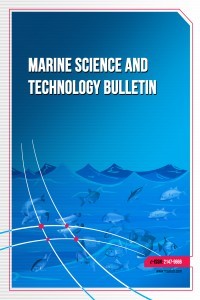
Marine Science and Technology Bulletin
Yazarlar: Sahire KARAYTUĞ, Gülsemin ŞEN AĞILKAYA, Deniz AYAS
Konular:Deniz ve Tatlı Su Biyolojisi
DOI:10.33714/masteb.432928
Anahtar Kelimeler:Lessepsian Species,Metals,Mersin Bay,North Levantine,Mediterranean Sea
Özet: The concentrations of iron, copper, zinc, chromium, arsenic, cadmium and lead were determined by inductively coupled plasma mass spectrometer (ICP-MS) in the muscle, gill, brain and liver tissues of lessepsian fish species sampled from Taşucu region located on the south of Turkish coastal waters in the Mediterranean Sea for all seasons. While iron showed the highest levels, cadmium showed the lowest levels in the examined tissues of all fish species (Pelates quadrilineatus, Upeneus moluccensis, Nemipterus randalli, Saurida lessepsianus). Metal levels showed tissue-dependent changes in the species studied. Cadmium was detected only in the liver tissue in all fish, in addition to a few other tissues (U. moluccensis’s brain tissues in summer season and P. quadrilineatus’s gill tissues in winter season). The maximum accumulation of Fe except for N. randalli and S. lessepsianus was detected in liver tissue. The maximum accumulation of Cu in all species was detected in liver tissue. The maximum accumulation of Zn except for S. lessepsianus was also detected in liver tissue. The highest accumulations of As and Cr in other fish species except for N. randalli were also detected in liver tissue. Except for As accumulation in N. randalli, the least accumulation for metals in all species was determined in muscle tissue. According to the seasons, there was no statistically significant relation between metal accumulations. Metal concentrations in edible parts of fish species were 17.26-108.22 µg g-1 dw for iron, 0.54-3.65 µg g-1 dw for copper, 11.50-31.17 µg g-1 dw for zinc, 0.32-1.09 µg g-1 dw for chromium, 4.32-69.44 µg g-1 dw for arsenic, below limit (not detectable) for cadmium, N.D.-1.12 µg g-1 dw for lead. In this study, for all metals except arsenic there is no health risk through an exposure of consumption of certain fish. Additionally, the results obtained for the elements in analyzed fish species were within acceptable limits for human consumption.
Dergi editörleri editör girişini kullanarak sisteme giriş yapabilirler. Editör girişi için tıklayınız.